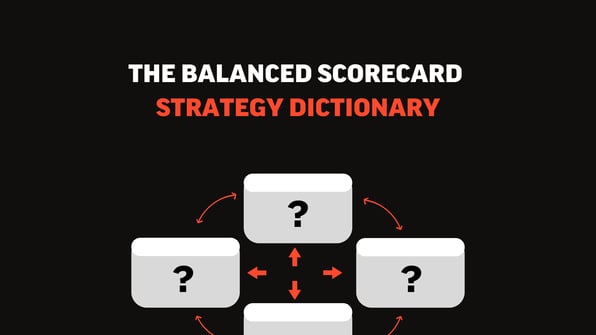How to align your team for strategy execution
.png)
Turning a group of employees into a high-performing strategy execution team is profitable more than just monetarily. It’s a win for the team members themselves; aligned, high-performing teams turn ordinary people to into local heroes. And it forges the way for even greater success as the Strategy Execution Management team’s example spreads throughout the organization.
What is team alignment, and how can we achieve it?
Teams are best aligned around what they plan to achieve, not their activities. Of course, the desired achievement requires a lot of doing, but the team aligning its activities around a common goal indicates its purpose. This is often called the line of sight, and it’s why the DecideAct platform clearly links actions to goals.
The GRIP model (Goals, Roles, Interpersonal relationships, and Processes) is a way to measure your team alignment's strength. It applies to team processes such as problem-solving, executing strategies, and running team meetings. This post will focus on the first element—alignment around clear and shared goals—since that’s the prerequisite for everything that follows.
Team members must consider the goal both attractive and realistic. In the absence of either, buy-in is challenging to achieve. Some team members might even oppose the whole project if they find it unclear, unattractive or unrealistic, and will have nothing to do with such an adventure. Other team members might participate because they’re required to, but won’t put their heart into their work. At best, this team will deliver mediocre results.
Why team alignment is vital?
Take the time to make sure your team understands your vision and how you plan to achieve it. Don’t assume everyone will catch up about how they’re expected to contribute, or that they even understand the goal clearly. An example of this type of miscommunication is when a team leader assumes that frugality comes first, when quality is actually most important. Some may feel this slows the process down, but it’s the only way to ensure alignment around the common goal.
For the goal discussion to create commitment from team members it needs to be perceived as attractive, yet realistic. If not, the team buys into the assignment as such, and there will be different levels of commitment among members. Some might even be directly against the whole assignment, either because they find it unclear, unattractive or unrealistic, and will have nothing to do with such an adventure. Often team members participate because they are required to do so, but they will not put their heart and soul into the task if they do not support it. Thus, the team will at best deliver mediocre results.
Work SMART
Specific, Measureable, Attractive, Realistic, and Time-based. The SMART model was introduced by Peter Drucker, a pioneer in modern management practices. His was the first systematic method of performance management by objectives (MBO). Others have refined his principles into systems such as Balanced Scorecard (BSC) and Objectives and Key Results (OKR). Their common thread is that goals and assignments must be SMART if they’re to succeed.
The SMART model corresponds to the Goals part of the GRIP model. Working SMART in goal-setting should be embedded in the your organization’s cultural DNA. Everyone should ask, What are the measureable deliverables? and How do they relate to our goals? If these questions have no clear answers, chances are the task is not worth the time.
How to tell if your team is misaligned
Everyone responsible for managing or creating a team for the purpose of Strategy Execution should always make sure there is team alignment before actually engaging in the assignment at hand. Such a check looks for possible signs of misalignment, i.e areas for improvements. Here are some signs useful to keep in mind:
- The goal is unclear and not shared. Team members have different views on what the goal is.
- Team members disagree about the assignment’s importance and/or relevance.
- Roles are ambiguous (or even not formally defined). There’s a general lack of accountability.
- No shared set of values guides the collaboration.
- There are no ground rules for collaboration.
3 tips to ensure team alignment for strategy execution
- Be sure the goal is clearly understood and shared.
- Clarify accountability within the team.
- Discuss and decide on a shared set of values within the team.
Get your strategy execution off to a great start!
Unfortunately, a lot of time is wasted in organisations through improper use of teams to execute strategic initiatives. In general, people don’t like their time being wasted, so more often than not, teamwork ends up being de-motivating. Yet, the potential of teamwork is tremendous and mostly untapped.
In this blog two simple models have been introduced: The GRIP model and the SMART Model. Both of them are proven and extensively covered in writing in the public domain. They are simple tools to check the level of alignment within the team. However, it may not be simple to apply them properly since it requires time, deep thinking and planning. But they clearly guide the way to a successful team, which in turn are the fundaments of effective Strategy Execution Management. This blog has focused on the Goal setting dimension of the GRIP model as a necessary start for everything else to follow.

Download your SEM Guide today!
The old “rah-rah” kickoff meetings were good for a few days of optimism at best; the 21st century marketplace demands more. The DecideAct platform helps illustrate team members’ roles in the organization’s plan for success. Action steps toward concrete goals, backed by real-time data, lead to a profitable organization with a healthy culture.








.png?width=80&name=Team%20Alignment%20(1).png)
.png?width=80&name=Strategy%20Evaluation%20(1).png)